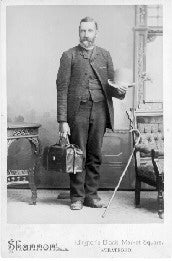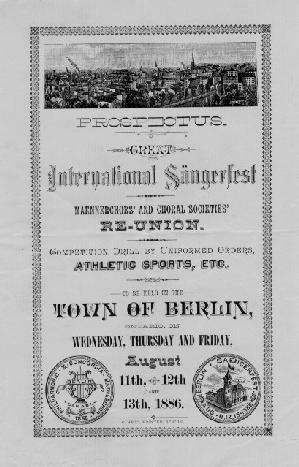Dana Porter Library, first floor
University of Waterloo Library
Waterloo, Ontario N2L 3G1
519-888-4567 x42619 or x42445
Library Newsletter, Vol. 27, No. 1, May 1996
Schantz/Russell Family Papers Donated
to the Doris Lewis Rare Book Room
 Shown here is itinerant book salesman Tobias Schantz with the book bag used in making his rounds in the local area. His diary, business papers, and collection of salesman's "dummy books" document aspects of the literary tastes and interests of the community.
Shown here is itinerant book salesman Tobias Schantz with the book bag used in making his rounds in the local area. His diary, business papers, and collection of salesman's "dummy books" document aspects of the literary tastes and interests of the community.
The University of Waterloo Library is pleased to announce the gift of the archival collections and library of the Schantz and Russell families of Kitchener. The Schantz/Russell Family Papers have been donated jointly by Mrs. Dorothy Russell and her son Harold Russell.
The collection centres around Tobias and Mary Schantz and their family, drawing together primary sources relating to several early pioneering families of Waterloo County including the Schantz, Moyer, and Bowman families. The five linear feet of archival materials spans a time period from 1840 to 1960 and is supplemented by a library of more than 800 volumes, photographs which add to the known body of work of local photographers, and a collection of maps, drawings, and plans, the earliest of which dates from 1824.
The textual records contain significant local history finds, including records of the Freeport Academy, the earliest known records of an educational institution in the area. More than 1,000 letters provide insight into the lives of pioneer families, highlighting especially the concerns of women. Also present are the diaries, daybooks, business ledgers, and correspondence of Tobias Schantz during his career as a nursery-stock salesman and itinerant book-agent.
Very cold and stormy, walked from Dundee to Mannheim to Petersburg & home, froze ear and tips of fingers.
Diary entry for 15 March 1893 by Tobias Schantz.
Records of Schantz's work as a book salesman are uniquely documented by more than 40 books known as "salesman's dummies." This outstanding collection is believed to be one of the largest of its kind available in Canada. Each sample displays the most noteworthy features of the book offered for sale, including the table of contents, the illustrations, selections from the text, and examples of the variety of elaborate styles of bindings available to the potential purchaser. Blank pages at the end of each sample book were used by the itinerant salesman to record his orders and, in this collection, some of the dummies contain up to as many as eight pages of handwritten lists of local subscribers to the books that Tobias marketed in his trips around the region. These books, in conjunction with Schantz's business papers, shed light on the reading interests of the local community and on the history of the Canadian book trade.
Included among the other 800 monographs are examples of 19th century Canadiana, books on horticulture, early school texts, scarce local imprints including the 1886-89 County of Waterloo Gazetteer and Directory as well as Assessment Roll of 1897 of the Town of Berlin and a large selection of Victorian literature. Many ornamental Victorian publisher's bindings are present. There are also extensive runs of early 20th century periodicals such as The Youth's Companion, St. Nicholas, The Ladies' Home Journal, and the Canadian Forestry Journal.

Front cover, including bird's eye view of Berlin/Kitchener, from the program entitled Prospectus. Great International Sängerfest...to be held in the Town of Berlin, August 11th, 12th and 13th, 1886 which was printed locally by the firm of C. Hett.
The collection on its own is significant locally; the cumulative significance is as great. When placed with other local family collections such as the Breithaupt Hewetson Clark collection, the Wagner Hailer Papers, the Clement/Bowlby Family Papers, and the Motz Papers, a rounded picture of the community as a whole begins to emerge and provides more depth and scope for researchers. There is now enough material in the Library's local collections to make meaningful thematic comparisons of the "German" settlement with other geographic areas.
For more information contact Special Collections & Archives.




